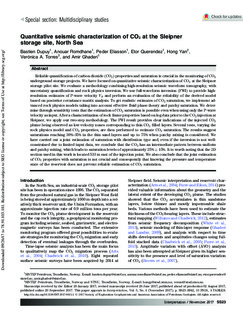| dc.contributor.author | Dupuy, Bastien | |
| dc.contributor.author | Romdhane, Anouar | |
| dc.contributor.author | Eliasson, Peder | |
| dc.contributor.author | Querendez, Etor | |
| dc.contributor.author | Yan, Hong | |
| dc.contributor.author | Torres Caceres, Veronica Alejandra | |
| dc.contributor.author | Ghaderi, Amir | |
| dc.date.accessioned | 2017-12-02T09:35:37Z | |
| dc.date.available | 2017-12-02T09:35:37Z | |
| dc.date.created | 2017-09-12T15:17:02Z | |
| dc.date.issued | 2017 | |
| dc.identifier.citation | Interpretation. 2017, 5 (4), SS23-SS42. | nb_NO |
| dc.identifier.issn | 2324-8858 | |
| dc.identifier.uri | http://hdl.handle.net/11250/2468823 | |
| dc.description.abstract | Reliable quantification of carbon dioxide (CO2CO2) properties and saturation is crucial in the monitoring of CO2CO2 underground storage projects. We have focused on quantitative seismic characterization of CO2CO2 at the Sleipner storage pilot site. We evaluate a methodology combining high-resolution seismic waveform tomography, with uncertainty quantification and rock physics inversion. We use full-waveform inversion (FWI) to provide high-resolution estimates of P-wave velocity VPVP and perform an evaluation of the reliability of the derived model based on posterior covariance matrix analysis. To get realistic estimates of CO2CO2 saturation, we implement advanced rock physics models taking into account effective fluid phase theory and patchy saturation. We determine through sensitivity tests that the estimation of CO2CO2 saturation is possible even when using only the P-wave velocity as input. After a characterization of rock frame properties based on log data prior to the CO2CO2 injection at Sleipner, we apply our two-step methodology. The FWI result provides clear indications of the injected CO2CO2 plume being observed as low-velocity zones corresponding to thin CO2CO2 filled layers. Several tests, varying the rock physics model and CO2CO2 properties, are then performed to estimate CO2CO2 saturation. The results suggest saturations reaching 30%–35% in the thin sand layers and up to 75% when patchy mixing is considered. We have carried out a joint estimation of saturation with distribution type and, even if the inversion is not well-constrained due to limited input data, we conclude that the CO2CO2 has an intermediate pattern between uniform and patchy mixing, which leads to saturation levels of approximately 25%±15%25%±15%. It is worth noting that the 2D section used in this work is located 533 m east of the injection point. We also conclude that the joint estimation of CO2CO2 properties with saturation is not crucial and consequently that knowing the pressure and temperature state of the reservoir does not prevent reliable estimation of CO2CO2 saturation. | nb_NO |
| dc.language.iso | eng | nb_NO |
| dc.publisher | Society of Exploration Geophysicists | nb_NO |
| dc.title | Quantitative seismic characterisation of CO2 at the Sleipner storage site, North Sea | nb_NO |
| dc.type | Journal article | nb_NO |
| dc.type | Peer reviewed | nb_NO |
| dc.description.version | publishedVersion | nb_NO |
| dc.source.pagenumber | SS23-SS42 | nb_NO |
| dc.source.volume | 5 | nb_NO |
| dc.source.journal | Interpretation | nb_NO |
| dc.source.issue | 4 | nb_NO |
| dc.identifier.doi | 10.1190/int-2017-0013.1 | |
| dc.identifier.cristin | 1493088 | |
| dc.relation.project | Norges forskningsråd: 233716 | nb_NO |
| dc.relation.project | Norges forskningsråd: 257579 | nb_NO |
| dc.description.localcode | © 2017 Society of Exploration Geophysicists. All rights reserved. | nb_NO |
| cristin.unitcode | 194,64,90,0 | |
| cristin.unitname | Institutt for geovitenskap og petroleum | |
| cristin.ispublished | true | |
| cristin.fulltext | original | |
| cristin.qualitycode | 1 | |
